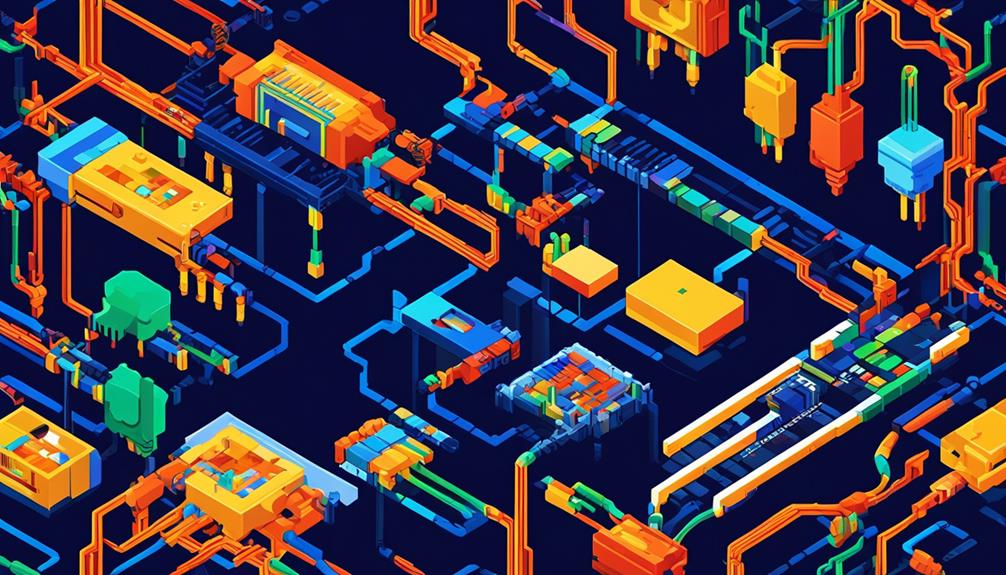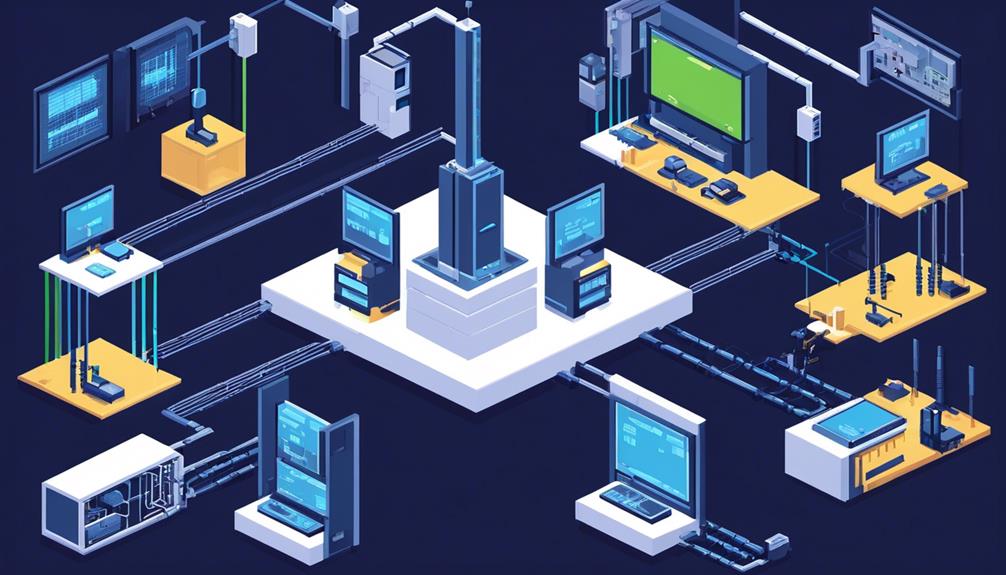In the rapidly evolving landscape of telecommunications, 5G technology has emerged as the next frontier, promising unprecedented speed, capacity, and connectivity.
However, behind the scenes, a complex web of hardware essentials lies at the heart of this cutting-edge technology. From antennas and base stations to fiber optic cables and network switches, each component plays a crucial role in delivering the enhanced performance that 5G networks offer.
In this discussion, we will explore the key hardware essentials required for the successful deployment and operation of a 5G network, shedding light on the intricate mechanisms that enable this revolutionary technology.
So, let's dive into the world of 5G hardware and uncover the building blocks that power the future of communication.
Key Takeaways
- Antennas and radios are crucial components of 5G hardware.
- Base stations and small cells play a vital role in the network infrastructure.
- Fiber optic cables and connectors are essential for high-speed data transmission.
- MIMO technology and beamforming enhance network performance and coverage.
Antennas and Radios

Antennas and radios are fundamental components of wireless communication systems. They enable the transmission and reception of radio signals wirelessly. Antennas serve as the interface between the electronic circuitry of a device and the electromagnetic waves in the environment. They capture and radiate radio frequency energy efficiently. Different types of antennas are used for various applications.
Dipole antennas are simple and widely used for general purposes. Yagi antennas are directional and provide high gain, making them suitable for long-range communication. Patch antennas are compact and lightweight, ideal for mobile devices. Parabolic antennas are large and highly directional, enabling long-distance communication.
Radios receive, decode, and play radio signals. They convert radio frequency energy into audio signals or data. Radios can be analog or digital and cover a range of frequencies, such as AM, FM, and shortwave. Analog radios use continuous waveforms, while digital radios use discrete signals represented by binary code. Digital radios offer improved signal quality, increased capacity, and enhanced features like error correction.
Understanding antenna design and radio wave propagation principles is essential for optimizing wireless communication systems. It allows for the selection of suitable antennas and radios, ensuring efficient signal transmission and reception. Knowledge of antenna and radio technologies enables the design of wireless networks that can handle the increasing demand for data in the era of 5G.
As wireless communication continues to advance, the significance of antennas and radios as hardware essentials cannot be overstated.
Base Stations and Small Cells
Base stations and small cells serve as vital components in cellular networks, seamlessly connecting mobile devices to the network and improving overall network performance. Here are four key facts about base stations and small cells:
- Base stations are the central connection points in cellular networks. They are typically larger in size and have a wider coverage area compared to small cells. Base stations are responsible for handling a large number of mobile device connections and providing network coverage over a broad geographical area.
- Small cells, on the other hand, are low-power radio access nodes that are designed to provide additional network coverage and capacity, particularly in densely populated urban areas or indoor environments. They are deployed in targeted areas to enhance network connectivity and reduce congestion.
- The deployment of base stations and small cells is crucial for optimizing network coverage, capacity, and quality of service. By strategically placing these network elements, service providers can ensure that users have reliable connectivity and a seamless mobile experience.
- Installing base stations and small cells needs to be easy and efficient. Service providers often have tight timelines, and they need the deployment process to be within 30 days. Therefore, having base stations and small cells that are easy to install and configure can greatly expedite the network deployment process.
Fiber Optic Cables and Connectors

Fiber optic cables and connectors form the backbone of high-speed data transmission in 5G networks. These cables, made of thin strands of glass or plastic, transmit data using light signals. Their high bandwidth allows for fast data transmission over long distances, making them ideal for 5G networks.
However, proper installation, maintenance, and troubleshooting of fiber optic cables and connectors are essential to ensure optimal performance.
During fiber optic cable installation, it is crucial to handle the cables with care to avoid bending or damaging them. Any kinks or breaks in the cable can lead to signal loss or degradation. Additionally, connectors must be properly aligned and joined to ensure minimal signal loss. Different types of fiber optic connectors, such as SC, LC, ST, and MTP, have specific features and applications, so choosing the right connector for the job is crucial.
Once the cables and connectors are installed, regular maintenance is necessary to maintain the quality of the connection. Cleaning the fiber optic connectors is particularly important, as any dirt, dust, or debris can interfere with the transmission of light signals. Using lint-free wipes and isopropyl alcohol, technicians can carefully clean the connectors to prevent signal degradation.
In the event of any issues with the fiber optic connection, troubleshooting becomes necessary. This involves identifying and resolving any problems that may be affecting the signal transmission. Common troubleshooting techniques include checking for loose connectors, inspecting the fiber optic cables for damage, and using specialized testing equipment to measure signal strength and quality.
MIMO Technology and Beamforming
The next essential component in 5G networks is MIMO technology and beamforming, which greatly enhance communication performance and optimize signal transmission and reception.
MIMO technology, standing for Multiple Input Multiple Output, utilizes multiple antennas at both the transmitter and receiver to improve wireless communication.
Beamforming, on the other hand, is a signal processing technique that focuses the transmission of radio waves in a specific direction, increasing the signal strength and quality.
Together, these technologies play a crucial role in enhancing the performance of wireless networks.
To better understand the importance of MIMO technology and beamforming, let's delve into their applications and performance analysis:
- Increased Data Throughput: MIMO technology allows for simultaneous transmission of multiple data streams, leading to a significant increase in data throughput. This enables faster download and upload speeds, enhancing the overall user experience.
- Improved Signal Reliability: By utilizing multiple antennas, MIMO technology improves the reliability of wireless signals. It reduces the impact of fading and interference, resulting in more reliable connections and reduced packet loss.
- Enhanced Coverage: MIMO technology helps extend the coverage area of wireless networks by leveraging spatial diversity. It allows for better coverage in areas with weak signals, ensuring a more consistent connection.
- Beamforming Algorithms: Beamforming algorithms dynamically adjust the direction of transmitted signals to focus them towards the intended receiver. This reduces interference and increases the signal-to-noise ratio, leading to improved connection quality and higher data rates.
Through extensive MIMO and beamforming performance analysis, it has been demonstrated that these technologies significantly enhance communication performance, optimize signal transmission and reception, and ultimately improve the overall efficiency and reliability of wireless networks.
Network Switches and Routers

Network switches and routers are essential components in 5G networks. Switching and routing play different roles in the network. Switching handles the local traffic within a network, while routing manages the traffic between different networks.
When it comes to performance and scalability, network switches and routers need to be able to handle the increasing data demands. They must provide low latency and high throughput to support the requirements of 5G applications and services.
Switching Vs. Routing
Switching and routing are fundamental components of network infrastructure that play distinct but complementary roles in directing data packets efficiently and securely.
- Switching refers to the process of forwarding packets within a local network, using MAC addresses to determine the destination.
Routing, on the other hand, involves directing packets between different networks using IP addresses.
- Packet switching, used in switching, breaks data into smaller packets that can be sent independently. Circuit switching, used in routing, establishes a dedicated path for the entire transmission.
- Switching is faster and more suitable for local network traffic, while routing is essential for connecting networks and directing traffic between them.
- Routing offers advantages over switching, such as the ability to handle different protocols, support for larger networks, and the ability to make intelligent decisions based on network conditions.
Performance and Scalability
Performance and scalability are crucial factors to consider when evaluating the efficiency and capability of network switches and routers in handling increasing network traffic and data processing. Network switches and routers need to be able to handle high data volumes and maintain consistent performance under heavy loads. Scalability is also important to accommodate growing network requirements. Features such as high-speed interfaces, advanced packet processing capabilities, and efficient forwarding mechanisms contribute to the performance and scalability of network switches and routers. Additionally, proper management of network resources, including bandwidth optimization, traffic management, and latency reduction, plays a vital role in enhancing their performance and scalability. These factors ensure that network switches and routers can effectively handle the demands of modern networks and provide reliable and efficient data transmission.
| Performance and Scalability |
|---|
| Bandwidth Optimization |
| Traffic Management |
| Latency Reduction |
Cloud Computing and Edge Computing
Cloud computing and edge computing are two distinct approaches to processing and storing data in the context of 5G networks.
Cloud computing, characterized by its centralized nature, offers scalability and accessibility from anywhere with an internet connection, making it suitable for applications that require extensive data processing and storage.
On the other hand, edge computing, with its distributed nature, enables real-time processing and low latency by processing data closer to the source, making it ideal for scenarios such as autonomous vehicles and industrial automation.
Understanding the benefits of edge computing, as well as the advantages of cloud computing, can help organizations make informed decisions regarding their network infrastructure.
Benefits of Edge Computing
Edge computing offers significant advantages in processing data closer to the source, resulting in faster response times for critical applications and enhanced data security. Here are four key benefits of edge computing:
- Reduced Latency: By processing data locally, edge computing minimizes the time it takes for data to travel to a centralized cloud server, reducing latency and enabling faster response times for time-sensitive applications.
- Data Security: Edge computing processes sensitive information locally, reducing the risk of data breaches during transmission to a centralized cloud server. This ensures that critical data remains secure and protected.
- Real-time Analysis: With edge computing, businesses can perform real-time analysis and decision-making at the edge. This enables immediate actions and insights without relying on cloud-based processing, allowing for faster response to changing conditions.
- Bandwidth Optimization: Edge computing reduces bandwidth usage by processing and filtering data locally. This minimizes the amount of data that needs to be sent to the cloud, optimizing network resources and reducing costs.
Cloud Computing Advantages
With the advantages of edge computing established, it is important to also consider the benefits of cloud computing in relation to both edge computing and overall data management strategies. Cloud computing offers several advantages, including cost efficiency, data accessibility, and scalability.
| Advantages of Cloud Computing | |
|---|---|
| Cost Efficiency | Cloud computing eliminates the need for businesses to invest in and maintain physical servers and infrastructure, resulting in cost savings. Businesses can pay for the storage and computing resources they need, making it a more cost-effective option. |
| Data Accessibility | With cloud computing, businesses can access their data and applications from anywhere, at any time, as long as they have an internet connection. This enables remote work and collaboration, increasing productivity and flexibility. |
| Scalability | Cloud computing allows for scalable and flexible storage, enabling businesses to easily adjust their storage needs as they grow. It provides the ability to quickly scale up or down resources based on demand, ensuring efficient resource allocation. |
Edge Vs. Cloud Comparison
When comparing cloud computing and edge computing, it is important to consider their differences in data processing and storage approaches.
Here are four key differences between edge computing and cloud computing:
- Data Processing:
- Cloud computing involves centralized data processing in remote servers.
- Edge computing processes data at or near the source of data generation.
- This enables edge computing to offer lower latency and reduced bandwidth usage compared to cloud computing.
- Application Focus:
- Cloud computing is suitable for applications requiring extensive data processing and storage.
- Edge computing is ideal for edge computing applications such as IoT devices, autonomous vehicles, and other applications requiring immediate data processing.
- Privacy and Security:
- Edge computing provides greater privacy and security for sensitive data as it minimizes the need to transfer data to centralized servers.
- Cloud computing relies on secure data centers for protection.
- Architecture:
- Edge computing has a decentralized architecture, with data processing happening closer to the source.
- Cloud computing has a centralized architecture with data processing happening in remote servers.
Power and Cooling Systems
Efficient power and cooling systems are crucial for the successful implementation and operation of 5G hardware. Power management, thermal design, and energy efficiency are key factors that need to be considered in order to ensure optimal performance and reliability.
Power management plays a critical role in 5G hardware as it helps to regulate and distribute power to different components. With the increasing complexity of 5G networks, power management becomes even more important to ensure that the hardware operates efficiently and reliably. This involves implementing power-saving techniques such as dynamic voltage scaling, clock gating, and power gating to minimize power consumption during periods of low activity.
Thermal design is another crucial aspect of 5G hardware. As the demand for data increases, so does the heat generated by the hardware. Effective thermal management is essential to prevent overheating, which can lead to performance degradation and even hardware failure. This involves designing efficient heat dissipation mechanisms, such as heat sinks, fans, and thermal interfaces, to ensure that the temperature of the hardware remains within acceptable limits.
Energy efficiency is also a key consideration in 5G hardware design. As energy consumption continues to rise, it is important to develop hardware that can deliver high performance while minimizing power usage. This can be achieved through the use of energy-efficient components, intelligent power management algorithms, and optimized circuit designs.
Testing and Monitoring Equipment

Testing and monitoring equipment is essential in the implementation and maintenance of 5G hardware, allowing for accurate measurement and analysis of electrical signals. Here are four ways in which this equipment is crucial for ensuring the smooth functioning of 5G hardware:
- Calibration Techniques: Testing and monitoring equipment needs to be calibrated regularly to ensure accurate measurements. Calibration involves comparing the readings of the equipment against known standards and adjusting them if necessary. This ensures that the equipment provides reliable and precise measurements, which is vital for troubleshooting and maintaining 5G hardware.
- Troubleshooting Methods: When issues arise in 5G hardware, testing and monitoring equipment can help identify and resolve them. Devices like oscilloscopes and logic analyzers enable engineers to visualize and analyze electrical signals, helping them pinpoint faults and rectify them. Troubleshooting methods supported by these tools ensure that any problems in the hardware are quickly identified and resolved, minimizing downtime.
- Remote Monitoring: In the context of 5G hardware, remote monitoring plays a crucial role in ensuring uninterrupted service. Monitoring equipment such as data loggers and spectrum analyzers allow operators to continuously observe the performance parameters of the hardware remotely. This enables them to detect any anomalies or deviations from the expected values, facilitating proactive maintenance and minimizing service disruptions.
- Maintenance and Quality Assurance: Regular monitoring and testing of 5G hardware are essential for maintaining its performance and ensuring high-quality service. By using testing and monitoring equipment, engineers can measure and verify the voltage, current, and frequency levels of the hardware, ensuring that it operates within the desired parameters. This proactive approach to maintenance and quality assurance helps prevent potential issues and optimize the overall performance of the 5G hardware.
Frequently Asked Questions
What Are the Different Types of Antennas Commonly Used in Wireless Communication?
There are several types of antennas commonly used in wireless communication. These include:
- Omnidirectional antennas, which radiate signals in all directions.
- Directional antennas, which focus signals in a specific direction.
- Sector antennas, which cover a specific sector of a circle.
Antenna selection should be guided by factors such as:
- Frequency range.
- Gain.
- Radiation pattern.
- Polarization.
Antenna performance comparison can be done based on parameters like:
- Antenna efficiency.
- Directivity.
- Radiation pattern.
How Does a Base Station Differ From a Small Cell in Terms of Coverage and Capacity?
In terms of network coverage and capacity, a base station differs from a small cell in several ways.
A base station typically has a larger coverage area and higher capacity as it is designed to provide service to a larger number of users over a larger geographic area.
In contrast, a small cell is typically used to enhance coverage and capacity in a specific localized area, such as a building or a street corner.
This allows for targeted coverage and capacity improvements in areas with high user demand.
What Are the Advantages of Using Fiber Optic Cables Over Traditional Copper Cables?
Fiber optic cables offer several advantages over traditional copper cables.
Firstly, they have a much higher bandwidth, allowing for faster transmission of data over long distances.
Additionally, fiber optic cables are immune to electromagnetic interference, resulting in a more reliable connection.
They are also much lighter and smaller in size, making installation and maintenance easier.
Moreover, fiber optic cables are more secure as they do not emit electromagnetic signals that can be intercepted.
How Does MIMO Technology Improve the Performance of Wireless Networks?
MIMO technology, which stands for Multiple-Input Multiple-Output, enhances the performance of wireless networks by using multiple antennas at both the transmitting and receiving ends. This technique allows for simultaneous transmission and reception of multiple data streams, resulting in increased capacity, improved signal quality, and enhanced network coverage.
With MIMO wireless advancements, networks can achieve higher data rates, reduced latency, and better overall reliability. By optimizing network performance, MIMO technology benefits various applications, including video streaming, online gaming, and large-scale data transfers.
What Are the Key Features to Consider When Selecting a Network Switch or Router for a Business Network?
When selecting a network switch or router for a business network, there are several key features to consider.
Scalability considerations involve evaluating the device's capacity to handle the network's growth and expansion.
Security features should include robust firewall capabilities, VPN support, and intrusion prevention systems.
Management options should provide centralized control and monitoring of the network, including features like remote configuration and monitoring.
These factors are crucial in ensuring a reliable and secure network infrastructure for a business.

